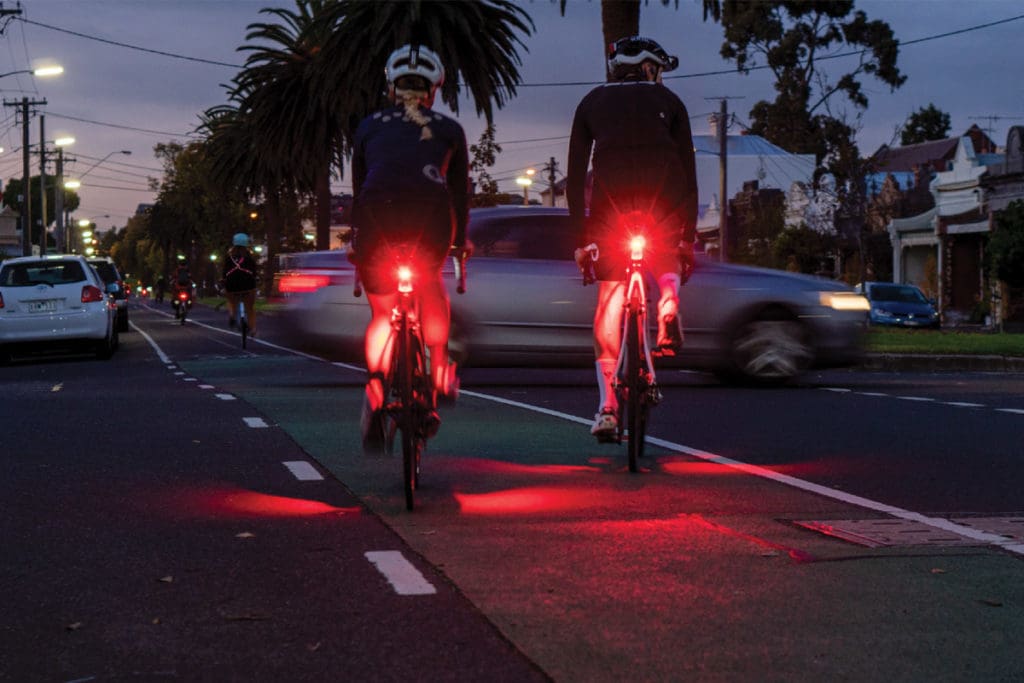Flock Light Using Rider Motion to Save Lives

Melbourne, Victoria
A Melbourne start-up developing a revolutionary new bike taillight will be looking to make valuable industry connections when it participates in the 2022 Micromobility Conference & Expo.
Project Flock recently officially launched the world’s first ‘bio-motion’ rear bike light, which directs light onto the rider’s legs to make them easier to see and more readily identifiable as a person.
Company founders Tim Ottaway and Marie Penny say the Flock Light leverages the human brain’s cognitive ability to recognise human movement very quickly, so riders can be seen up to 5.5 times faster than a standard red light.
More importantly, the light’s ability to clearly to show the rider as human can influence motorist behaviour.
“And it does so without blinding or startling other road users. It’s a rear light designed as much for other people on the road as it is for cyclists,” they say in a statement.
Project Flock raised $78,000 during a Kickstart crowd sourcing campaign from mid-August to mid-September, and has attracted around 700 pre-orders for the light’s anticipated release late next year.
The company has produced 16 fully functioning prototypes which are now being road tested by a combination of high-profile riders and recreational cyclists, dubbed the Flock Pilots.
“They’ve been testing the light for three weeks each and providing their feedback,” Tim said.
“It’s all part of finalising the design and we’re aiming to start pre-production early next year.
“We’re promising to start delivering product to customers in September or October 2023.”
In the meantime, Tim and Marie are hoping the Micromobility Conference & Expo will help them establish valuable connections in the industry.
Project Flock spawned from a university project in 2019, when Tim was completing his final year of industrial design at the Royal Melbourne Institute of Technology (RMIT).
He discovered research from South Carolina’s Clemson University that demonstrated that highlighting a cyclist’s biomotion made them much more conspicuous. The idea of the Flock Light was born.
Its innovative yet simple approach to improving cycling safety has won two international design awards, as well as the James Dyson Award for Australia.
“The unfortunate side effect with bike lights using brightness and flashing patterns to increase visibility, is this can often have the adverse effect of blinding or aggravating other road users,” according to the statement.
“It also fails to focus on what’s actually important – the human on the bike.”
Flock Light also enables drivers to better judge the distance to the cyclist, and Tim and Marie felt all these factors could go a long way to reducing cyclist-related crashes and collisions.
In Flock Light designs also addresses other ‘pain points’ for cyclists.
It includes a ‘Flight Time Gauge’ that clearly shows the remaining better charge level and the time remaining before the charge runs out, to avoid getting caught out by a flat battery.
In addition, the Flock Light has a simple grip clip system that seals the USB-c port once the light is fitted on the bike, and can be easily clipped and removed with one hand.
As an avid cyclist who has raced bikes, participated in bunch rides and completed long-distance cycling trips, Tim says he has seen his fair share of serious cycling crashes.
His business and life partner, Marie, is an architect who has experienced her own “trepidations of cycling through Melbourne’s busy high streets”.
She says she always struggled to identify as a ‘cyclist’, especially because of her lack of confidence jumping on a bike, and understood the need to feel recognised as a legitimate road user.
The duo say the Flock Light, which will retail for A$120, is just the first of a range of products they intend to bring to market to foster a safer coexistence of road users.
Project Flock will be exhibiting at the Micromobility Expo. Further information about the Flock Light is also available at www.projectflock.cc or by following Project Flock on Facebook and Instagram.
